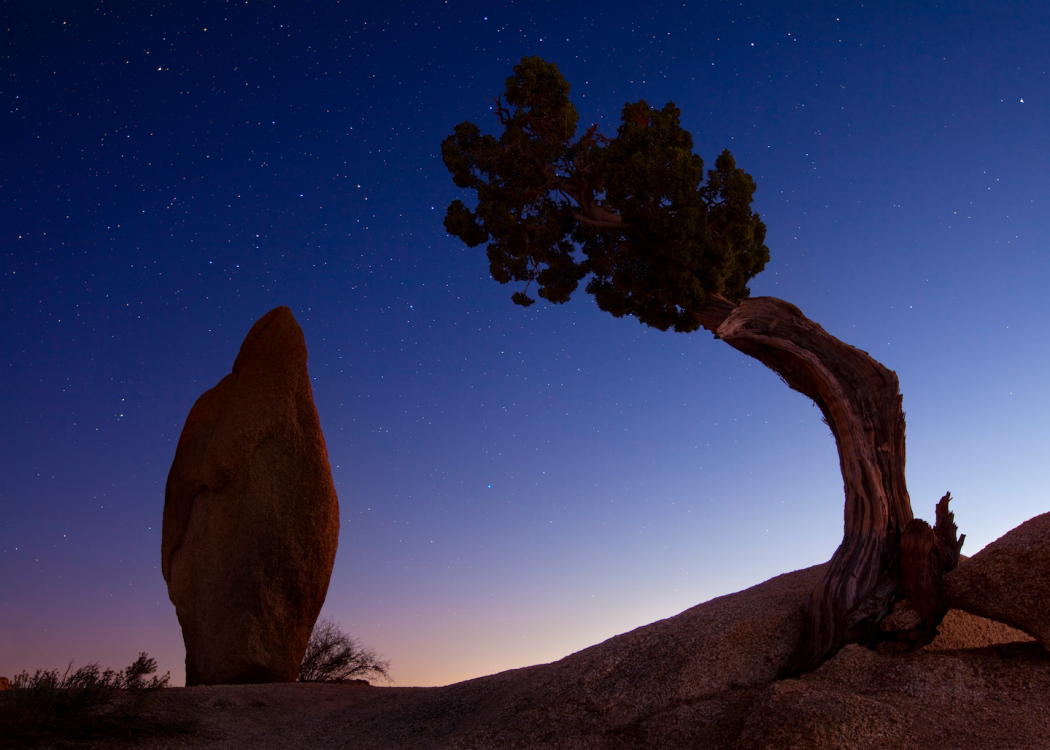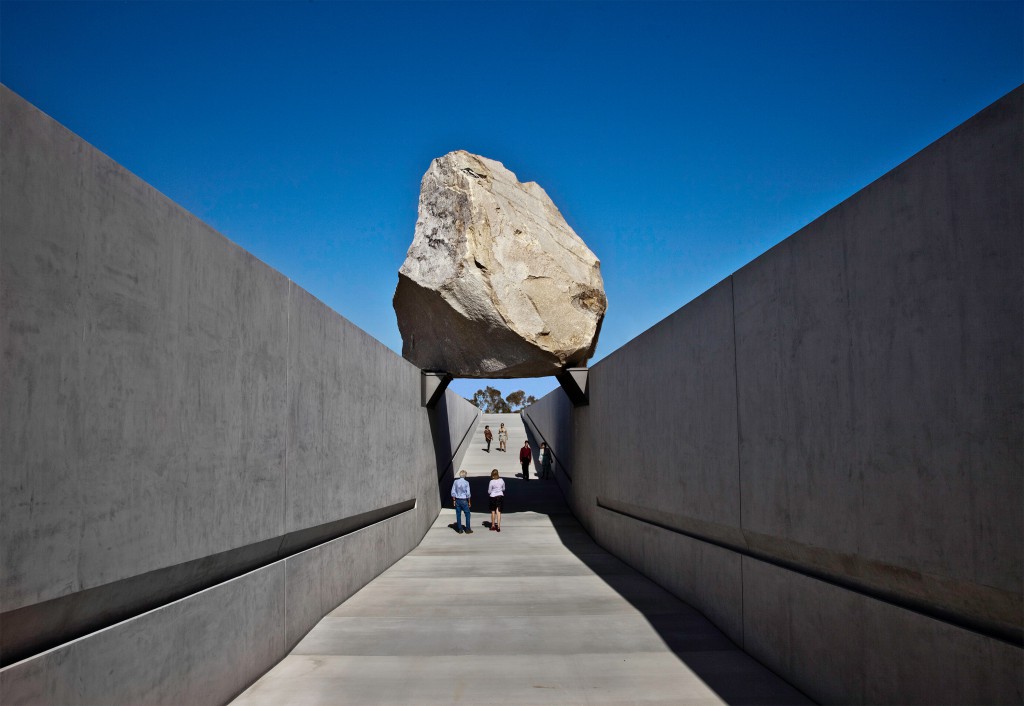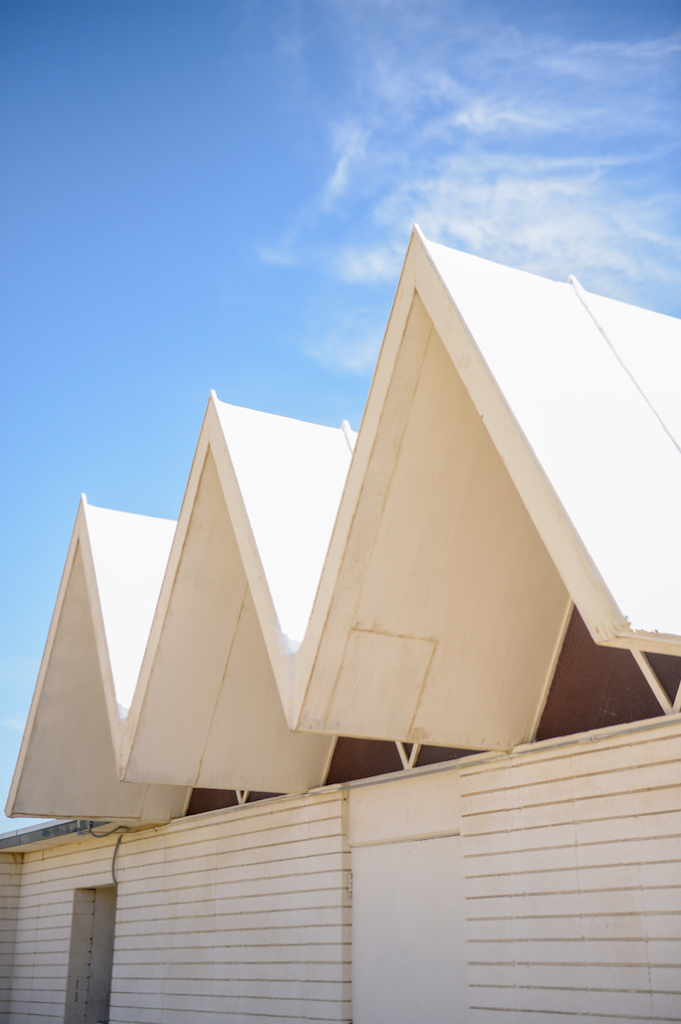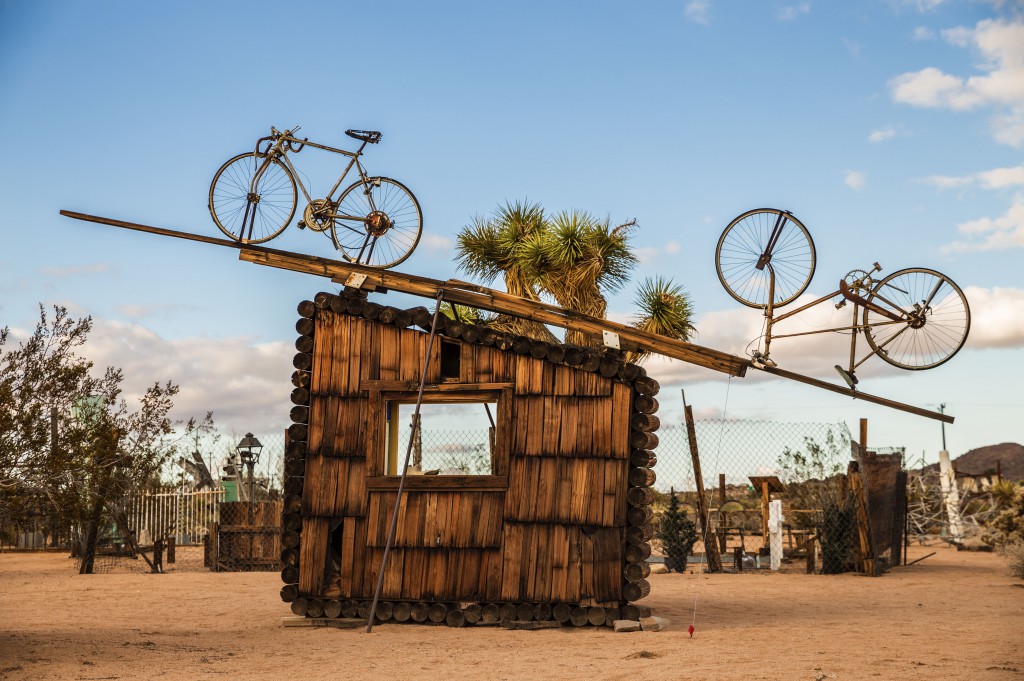Desert Aesthetic: Finding a Creative Oasis in Joshua Tree, California
The tone of our journey to Joshua Tree is set before we even leave LA. Pulling up outside the Los Angeles County Museum of Art (LACMA), we venture past the high metal railings enclosing Michael Heizer’s epic outdoor sculpture, Levitated Mass. For the middle of the city, the compound is relatively quiet, and the titular mass looms large across the open space outside the museum. I hear the crunch of our shoes on sand, not for the last time this trip.

The work consists of a massive 900 million-year-old, 340-tonne boulder, suspended above a trench that dips below ground level. It’s deceptively simple — my travel buddy, Cory, certainly doesn’t see the point. However, this artist’s influence on conceptions of landscape, as well as definitions of ‘art’, is significant, and Levitated Mass is the most ambitious public project he has pulled off to date. Heizer pioneered the idea of ‘negative sculpture’: removing matter to create negative space rather than building up a form. Combining this idea with landscape art, which engages with the materials of the earth, his work often involves cutting into the morphology of a site. The artist is also interested in the juxtaposition of forms and materials, considering how they relate to one another spatially, and often temporally as well.

LACMA Director Michael Govan suggests that Levitated Mass, both modern and ancient, fuses a monumental absence with a monumental presence. This creates a complex sense of perspective: on the one hand, all this monumentality speaks to our insignificance in space and time, while on the other, its very existence — the result of decades of planning, millions of dollars, and, in the transportation of the boulder through the city to the site, cooperation the likes of which local bureaucrats had never seen — represents the power we wield to mould the world and create markers that will speak to future generations.
According to Chrissie Iles, Curator at the Whitney Museum in New York, such an environment also acts to increase our awareness of space — our relationship to it, and movement through it. I gaze up at the boulder, tracing its outline against the sky, before strolling beneath, noting the way its form shifts with every move we make. Coming up and out the other side of the trench, I look up again, observing the mass from yet another perspective. Others walk at ground level alongside the trench, reaching out to touch the rock in a somewhat reverential way. It’s been suggested that certain objects, be they from space or deep within the earth, draw us to them with their energy, and this boulder appears to be one of them.
One final glance and we jump back into the car and onto the highway. No doubt influenced by Levitated Mass, I find myself noticing the way concrete overpasses position and reposition themselves against the blue Californian sky as we drive past. Once out of the city, we try, and fail, to capture on phone cameras our pivoting view of a field of windmills spinning as they gather the forces of the strong wind that buffets our vehicle. Exiting towards Joshua Tree, the road takes a turn, orienting us perpendicular to the hills and offering a strikingly panoramic view of our desert surroundings. We wind up through the hills and begin passing through the towns that border the park: while Morongo Valley has the vibe of a small highway settlement, Yucca Valley is surprisingly developed, with strip malls, big box stores, and fast food joints lining the highway.
A few kilometres out of Yucca Valley, we reach the Joshua Tree Retreat Center. This 170 hectare site was founded in 1941 by Edwin J. Dingle, who had recently returned from a spiritual awakening in Tibet. Having made his fortune mapping China in the early 1900s, Dingle wished to build a retreat to share his philosophy of ‘mentalphysics’ — a combination of meditation, breath work, and affirmations designed to lead to a state of balance among body, mind, and spirit. Dingle’s legend has him discovering the site while driving along a desert road, before being overwhelmed with the compulsion to pull over and stop. He reported a burst of light from the heavens, illuminating the landscape, and a voice predicting that “The desert will bloom like a rose… someday there shall be cities built around the land. Great highways shall lead here as a place of respite.” As we pull off the main road, transitioning from the business environs of Yucca Valley to the calm of Dingle’s retreat, it seems that his vision did indeed come to fruition. This is later confirmed when we learn of the numbers of people who undertake pilgrimages from around the world to attend retreats facilitated here by leaders in their fields.

The centre is built on 18 vortices — places of intensified energy patterns within the earth that serve to amplify physical, mental, emotional and spiritual states. It’s this characteristic that some consider to be behind the power of any sacred site. In building a retreat in such an environment, the intention is to encourage practices that allow the power of the vortex to be directed in such a way that it promotes insight, healing, and creativity. This energy was further harnessed architecturally by Dingle in collaboration with Frank Lloyd Wright, and his son Lloyd Wright. The buildings represent a synergy between Dingle’s proponence of Vastu building philosophy — which centres around orientation and alignment in relation to the movement of the sun through the day, ideal proportions, the use of sustainable materials, and the influence of the natural environment — and Wright’s ‘organic architecture’, which integrates structures into their sites, creating a harmonious composition.
We explore the grounds the next morning. Boots crunching on sand once more, we march quietly, out of respect for those undertaking silent meditation in the nearby buildings. Approaching the Sanctuary — the retreat’s largest meeting space and an original Wright design — its integration with the landscape is clear. Its angles seem to rise straight out of the ground, ascending to a peak and spire. Inside, it becomes apparent that the vaulted ceiling consists of 10 triangular panels. This structure means that the Sanctuary’s acoustics are incredible. Ken Davis, the relaxation musician, keeps a crystal piano here permanently, on which he performs a concert once a year: we peek under the cover and speculate as to what the instrument might sound like, but don’t dare play a note. Thinking back to the wind farm, I consider the transfer of energy within this space — the elusive natural energy of the site from the vortex directly beneath, channelled through this architecture into soundwaves circulating around the room and connecting with the human actors inside it.
The centre’s buildings all prominently feature rock sourced from a quarry on the property, which allows maintenance to preserve the original intent and materiality of the architecture. It’s also used to create new features, such as the Chalice Well Pond. This pond is situated on one of the energy vortices within the property, and its design references the form of the vesica piscis, or intersecting circles, seen in the famed Chalice Well of Glastonbury — where the Holy Grail is reportedly buried. As the water of the pond pours down each level of the fountain, it spirals down and around a network of circular vessels, imitating the whirling energy of the vortex beneath — a tangible rendering of the flow of soundwaves that I had envisaged within the Sanctuary. Here, the purpose is to energise the water’s spiritual, healing properties, ignited within the pond by drops brought from the renowned healing sites of Lourdes and Medjugorje. This is further supported by crystals and gemstones laid beneath the foundation, each inflecting their own spiritual properties into the pond. This area of the centre is used as a calm site for relaxation, prayer, or meditation, and also for physical anointing. We dip our hands in and find the water surprisingly cold.
The next phase of our journey of aesthetic discovery is tucked away down a small, unobtrusive dirt road, well off the highway. An artist and educator, Noah Purifoy was influential in his dedication to the practice of found object assemblage sculpture, and in his vision of art as a tool for social change. Initially working within the urban environment of Watts, the artist relocated to Joshua Tree in 1989. Purifoy’s Outdoor Museum is the culmination of his final 15 years of work, resulting in a surreal 10 acres of large-scale sculpture, built entirely from junk materials. The constructions merge his assemblage sculpture with land art, relocating and re-contextualising his earlier practice.
The site is a complex network of interrelationships. Each piece of debris has an individual history, and a new role in collocation with the other pieces it is now placed alongside; both aspects contributing to the nature of the larger cumulative ‘whole’ they create. Similarly, each work stands on its own, and in relation to other sculptures within the surrounding environment. Crunch, crunch, crunch: we split up, wandering in different directions to explore individually. Though his work has a strong political dimension, what strike me most are Purifoy’s strategies of framing and enclosure: ‘windows’ and archways repeatedly bring into focus other works or aspects of the environment, while detailed spaces are contained within boundaries constructed of rusted tin, wire mesh, or a simple rope.

Like Heizer’s work, these techniques encourage a heightened awareness of our own existence in relationship to spaces and our movement through them. I experience Purifoy’s environments from the outside, the inside, this angle and that, experimenting with my own placement in relation to them and finding a new perspective, a previously unregistered detail, every time. The nature of these details — vestiges of life that would otherwise be considered worthless — has its own impact. Old clothing, furniture, books, electronic parts, all are left to weather away out here in the desert. In this way, the site is both a time capsule and a constantly evolving — or devolving — organism, and each interpretation serves as a reminder of our own temporary status on this planet, raising the question of what traces, material or otherwise, we will leave behind.
Still feeling the effects of Purifoy’s extraordinary undertaking — some of which, serendipitously enough, featured in the Junk Dada exhibition back at LACMA — we move on to the Joshua Tree National Park itself. As we approach the park’s west entrance — one of three points of entry — more and more of its iconic trees and rock formations emerge from within the desert landscape, the latter looking from this distance like miniature mountains of piled-up pebbles. We discuss their origins, pushed up out of the earth by massive geological forces. It’s said that the park is vortex-heavy too. Certainly, in looking at this landscape, it seems obvious that there is something potent simmering beneath the surface surrounding us — with no architectural or land art remodelling required.

On entry, we stop and purchase our car pass — US$15 for seven days’ access — and begin winding our way into the park. The pass slides back and forth across the dashboard as we navigate the turns while wondering at the views all around us. Every so often, the road indicates an ‘Exhibit Ahead’, as if we were in a massive outdoor museum, even more expansive in time and space than Purifoy’s. However, everywhere we look could be considered a good place to stop and explore: this landscape is an embarrassment of scenic riches and my eyes want to soak up every last one of them.
Not far into the park, we reach Hidden Valley. The campgrounds and picnic facilities throughout the park are basic but tidy and well-maintained, and this is no exception. Heading straight for the trail, we make our way through a small passage between two large boulders to find a concealed clearing of sorts, with smaller boulders and trees surrounded by much bigger, imposing rock structures. We stick to the trail for the most part, which has an organic feeling to it, consisting of cleared sand bordered by small rocks, occasional stone steps, and subtle but clear arrows and information points along the way. I realise that all our recent engagement with art and architecture has ultra-attuned me to my mediated interaction with this natural environment.
As we crunch our way along the path, we see tiny figures clinging to the sheer faces like Spider-Man, and silhouettes of others perched on the tops of these mighty forms. Vowing to emulate them tomorrow, we take an easier road to an elevated perspective with a drive up to the Keys View Lookout, which provides a remarkable vista across Palm Springs, Coachella, the San Andreas Fault and the Salton Sea. In the background, the mountains progressively fade into a haze due to the Los Angeles smog, creating a clear delineation of distance that is quite beautiful if one ignores its environmental implications. It’s a satisfying end to an exhausting, but enriching day.
The following morning we leap out of bed bright and early, keen to get back to the park and make the most of it. Old hands at this by now, we drive assuredly towards the entrance, waving our permit for the ranger as we go through. This time, we travel a little deeper into the park, stopping at the iconic Jumbo Rocks. Like Hidden Valley, this area features a campground and trail, but its main appeal is the eponymous rocks. We go off-trail this time, scampering over boulders like billy-goats. Today it is less about following a set path to a predetermined destination and more about forging our own. We take turns choosing the direction and collaborate to problem solve our way out of the sticky situations we undoubtedly find ourselves in when the boulders got too steep or the chasms too wide. It’s challenging and invigorating.
Next up is the Cholla Cactus Garden, a field of cacti as far as the eye can see. As we walk among them, we notice many are charred in places, the result of frequent fires. However, plenty are surviving and new growth is clearly apparent; after several days of keeping my eyes open for meaning in our surroundings it’s tempting to draw a metaphorical lesson from the garden’s persistence against adversity. But we have more rocks to climb. We make a final stop at White Tank, a less renowned campsite surrounded by slightly smaller rocks than Jumbo, making for more achievable clambering over and among them. We’re confident now, leaping without having to stop and strategise — our feet know where they’re going.
As we approach the trail’s distinctive Arch Rock, an information sign tells us its curved structure is the result of weathering, which will only continue until eventually Arch Rock is no more. Like Purifoy’s weathered detritus, it’s a reminder that despite the immutability we might ascribe to this monumental landscape, it’s as much in a state of flux as we are — albeit on a much grander time scale.
